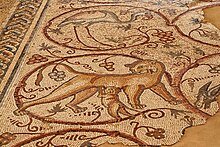Gaza Synagogue
The Synagogue of Gaza was a Jewish house of prayer from the Byzantine period (6th / 7th centuries) in Gaza-Maiumas. It was a very representative, five-aisled basilica on a floor space of 30 × 26 meters, with three entrances in the west and an apse on the east wall.
Discovery, vandalism, restoration
The Egyptian Antiquities Administration dug here in 1965 and initially announced that they had come across a church. When Israeli archaeologists arrived in 1967 for rescue excavations, they found the mosaic, which had remained unattended since it was uncovered, already badly damaged by vandalism. David's head and hand in particular had been destroyed. The remains of the mosaic were saved and brought to the Israel Museum in Jerusalem for restoration, where they became part of the permanent exhibition. David's face is a reconstruction that was made with the help of a photograph. Today the fragments of the Gaza mosaic in are Museum of the Good Samaritan close to Ma'ale Adumim shown.
Description of the mosaics
Originally, the entire floor was covered with mosaics, but when the building was discovered, only remnants were left in the southernmost aisle and in the central nave.
The aisle was adorned with an animal mosaic, with grape tendrils connecting a number of medallions with exotic animals such as tigers, flamingos, giraffes and a zebra. The style was compared by Michael Avi-Yonah to that of the Synagogue of Maon (Nirim) and the Synagogue of Naaran . One of the medallions contained a foundation inscription, according to which Menachem and Isoyos, sons of the timber merchant Isses, donated the mosaic in the year 569 of the Gaza era (= 508 AD).
In the central nave there was a representation of King David playing kithara (identified by a Hebrew inscription: דויד). He is dressed like a Byzantine emperor. What is even more remarkable is that the iconography was adopted from Orpheus, who made music . There are fragments of the animals gathered around David and listening to his game: a lioness, a giraffe and a snake. According to Rachel Hachlili , the mosaics in the Gaza Synagogue show similarities with the mosaics in the Byzantine Church of Jabaliyah, also in the Gaza area. “Workshops and artists worked for neighboring synagogues and churches alike, fulfilling the wishes of both Jewish and Christian customers. ... The same designs were used here as there, with the addition of specific symbols for the respective client. "
Web links
- Center for Online Judaic Studies: Gaza Synagogue Mosaic, 6th century CE
literature
- Othmar Keel , Max Küchler : Places and landscapes of the Bible. Volume 2: The South. Vandenhoeck & Ruprecht, Göttingen 1982, ISBN 3-525-50167-6 . Pp. 91-95.
- Rachel Hachlili: Ancient Synagogues - Archeology and Art: New Discoveries and Current Research. Brill, Leiden 2013. ISBN 978-90-04-25773-3 .
Individual evidence
- ↑ Rachel Hachlili: Ancient Synagogues . S. 593 .
Coordinates: 31 ° 31 ′ 13.9 ″ N , 34 ° 25 ′ 57.2 ″ E

